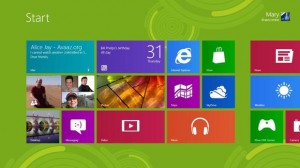 Microsoft announced yesterday that it has completed the development and testing of Windows 8, a major upgrade of its OS for desktops, laptops and tablets and one of the most important product releases in the company’s history.
Microsoft announced yesterday that it has completed the development and testing of Windows 8, a major upgrade of its OS for desktops, laptops and tablets and one of the most important product releases in the company’s history.
Now Windows 8 is available to hardware makers that will release new PCs and tablets with the OS at the end of October, when the product officially starts shipping commercially.
“Together we are bringing to customers a new PC experience that readies Windows PCs for a new world of scenarios and experiences, while also preserving an industry-wide 25-year investment in Windows software,” wrote Steven Sinofsky, president of the Windows and Windows Live Division wrote in a blog post.
Now it’s crunch time for Microsoft. “Obviously, this is not the end, it’s just the beginning,” said Gartner analyst Michael Silver. “Now Microsoft — and all its partners — need to execute all of it.”
Windows 8 will run on devices with x86 chips from Intel and AMD, as well as on devices that use ARM chips. The ARM version of the OS is called Windows RT.
After hitting this RTM (release to manufacturing) milestone, Microsoft is reiterating the Oct. 26 date for the commercial availability of the OS in new devices as well as in stand-alone form as an OS upgrade on existing Windows PCs.
Microsoft has already announced two upgrade special offers for users with machines running Windows 7 and other versions of the OS.
Some Microsoft customers and partners, however, will get early access to Windows 8 this month, including developers, who will be able to download the OS through their MSDN (Microsoft Developer Network) subscriptions starting on Aug. 15. On that same day, IT professionals testing the OS in their companies will gain access to it via their TechNet subscriptions.
On Aug. 16, the gates open for customers with Software Assurance contracts, who will get access to the Windows 8 Enterprise edition, as well as for Partner Network members who will be able to get Windows 8.
Four days later comes the turn for Microsoft Action Pack Providers, and on September 1st Volume License customers without Software Assurance will be able to buy Windows 8 from Volume License Resellers.
With Windows 8 and its new Metro interface optimised for devices whose screens support touch and stylus input, Microsoft will try to improve the operating system’s weak position in the tablet market, widely dominated by Apple with its iPad.
Microsoft has seen in recent years as consumers have embraced tablets, particularly iPads, not only for personal use but also, to the surprise of many, for work, triggering the trend known as BYOD (bring your own device) to the office.
Microsoft’s sense of urgency is such that it has even decided to release its own Microsoft-branded tablet, to improve the chances of success for Windows 8 in this market, although the move has rubbed some of its device manufacturing partners the wrong way.
A key question for Windows 8 is how much support it will get from application developers, a crucial element in the success or failure of a new OS. In its RTM announcement on Wednesday, Microsoft pointed out that come Aug. 15, developers will find in the Windows Development Center “all the tools and resources” needed to build Windows 8 applications, including the final build of Visual Studio 2012.
Gartner estimates that there will be around 150 million PCs sold to consumers pre-loaded with Windows 8 in this year’s fourth quarter, which should be a big enough audience for Microsoft to attract a lot of app developers to the Windows Store, Silver said.
“But so far the store is not very user-friendly and doesn’t have enough of the titles that have made iOS so successful. It better be much better by the Oct. 26 launch,” he said via email.
It also remains to be seen how compelling the new Windows 8 devices will be in terms of functionality and pricing, an issue that will make or break the OS, he said.
There are questions around enterprise adoption, because most companies have either recently migrated from XP to Windows 7, or are in the process of doing so, and will likely stay on Windows 7 for several years at least before embarking on another major OS upgrade.
In a blog post about the RTM milestone, Erwin Visser, senior director of the Windows Commercial Business Group, said Microsoft recommends that enterprises deploying Windows 7 forge ahead, but that they also simultaneously evaluate Windows 8.
“There is great compatibility between Windows 7 and Windows 8, and this will make it easier for customers to start adopting Windows 8 side-by-side with Windows 7,” he wrote.
However, for customers running Windows XP or Windows Vista, and still early in their Windows 7 deployment process, Microsoft recommends they start their Windows 8 deployment planning, according to Visser.
For Silver, this last recommendation is a “huge disservice” to Microsoft customers, in particular the ones running Windows XP. “To take the little progress some have made so far and stall it so they can start to wait the 12 to 18 months that will be needed to get good vendor support for Windows 8 is a huge mistake,” Silver said.
Most security and management products will need new releases and upgrades to work under Windows 8, he said. Even if an application works on Windows 8, enterprises need to consider whether the application’s vendor will support it and what the implications may be of pushing ahead without the vendor’s support.
For example, Silver wonders how well will enterprises that use Microsoft’s own System Center Configuration Manager 2007 be able to manage Windows 8 and Metro applications, and how long will it take them to upgrade to the product’s 2012 version.
“There’s little to no chance that organisations with Windows XP that haven’t made any progress moving to a mature, stable Windows 7 over the last 3 years will be able to get Windows 8 done before Windows XP support ends in April 2014,” Silver said.





